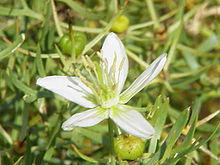| Peganum harmala | |
|---|---|

| |
| Harmal (Peganum harmala) flower | |
| Scientific classification | |
| Kingdom: | Plantae |
| Clade: | Tracheophytes |
| Clade: | Angiosperms |
| Clade: | Eudicots |
| Clade: | Rosids |
| Order: | Sapindales |
| Family: | Nitrariaceae |
| Genus: | Peganum |
| Species: | P. harmala
|
| Binomial name | |
| Peganum harmala | |
| Synonyms | |
| |
Peganum harmala, commonly called wild rue,[1] Syrian rue,[1] African rue,[1] esfand or espand,[6] or harmel[1] (among other similar pronunciations and spellings), is a perennial, herbaceous plant, with a woody underground rootstock, of the family Nitrariaceae, usually growing in saline soils in temperate desert and Mediterranean regions. Its common English-language name came about because of a resemblance to rue (to which it is not related). Because eating it would sicken or kill livestock, it is considered a noxious weed in a number of countries. It has become an invasive species in some regions of the western United States. The plant is popular in Middle Eastern and north African folk medicine. The alkaloids contained in the plant, including the seeds, are monoamine oxidase inhibitors (Harmine, Harmaline).[7]
- ^ a b c d e "Peganum harmala". Germplasm Resources Information Network. Agricultural Research Service, United States Department of Agriculture. Retrieved 17 February 2008.
- ^ Ghafoor A (1974). Nasir E, Ali SI (eds.). Flora of Pakistan, Vol. 76 Zygophyllaceae. Karachi: Missouri Botanical Garden Press and the University of Karachi. p. 7.
- ^ a b c d e f g h "Peganum harmala L." Plants of the World Online, Kew Science. Royal Botanic Gardens, Kew. 2019. Retrieved 22 February 2019.
- ^ a b c "CJB – African plant database – Detail". African plant database. Conservatoire et Jardin botaniques & South African National Biodiversity Institute. 2012. Retrieved 19 February 2019.
- ^ a b c d "Peganum harmala L. — The Plant List". www.theplantlist.org. Archived from the original on 13 September 2019. Retrieved 23 November 2012.
- ^ Mahmoud Omidsalar Esfand: a common weed found in Persia, Central Asia, and the adjacent areas Encyclopedia Iranica Vol. VIII, Fasc. 6, pp. 583–584. Originally published: 15 December 1998. Online version last updated 19 January 2012
- ^ Massaro EJ (2002). Handbook of Neurotoxicology. Humana Press. p. 237. ISBN 978-0-89603-796-0.[permanent dead link]